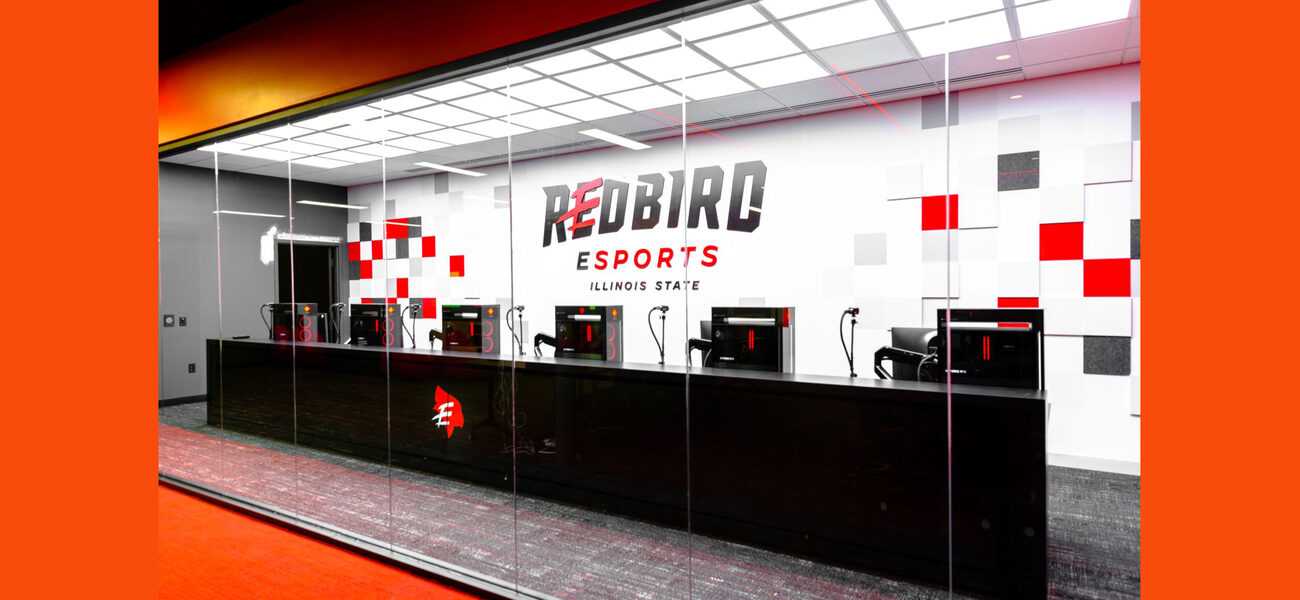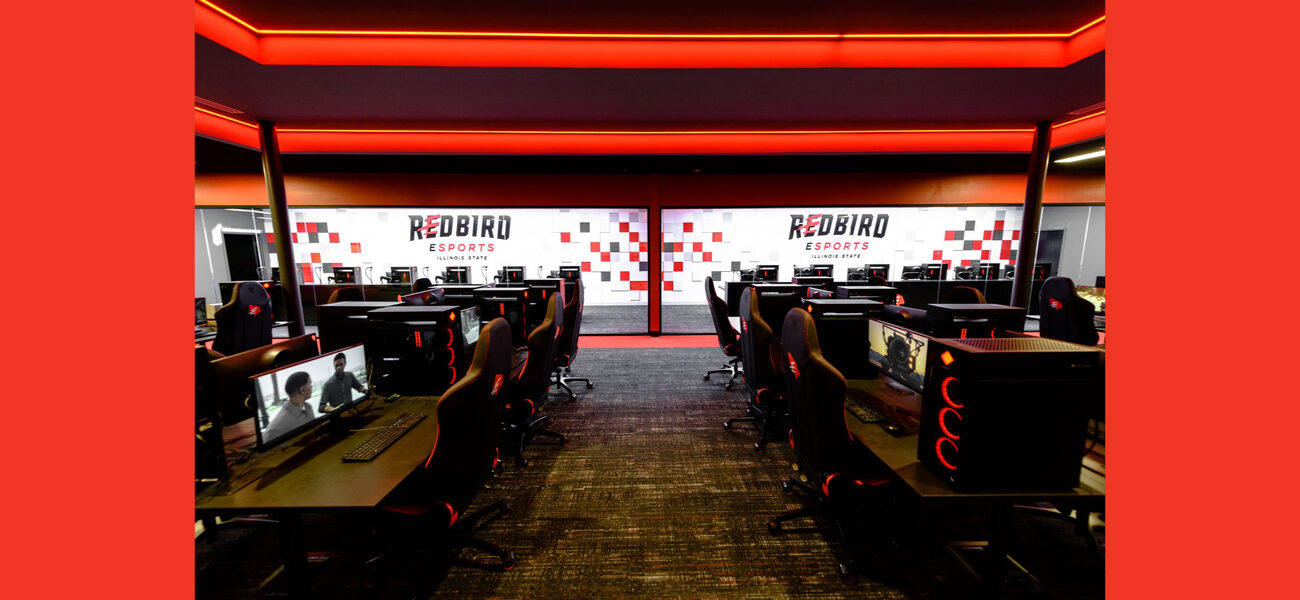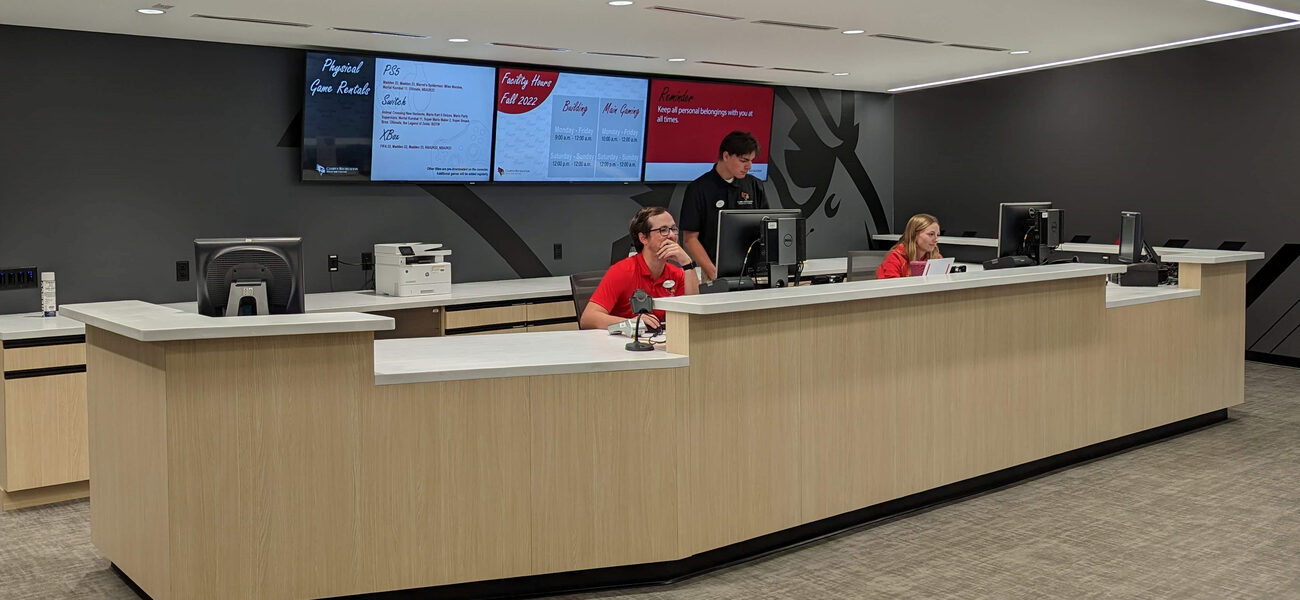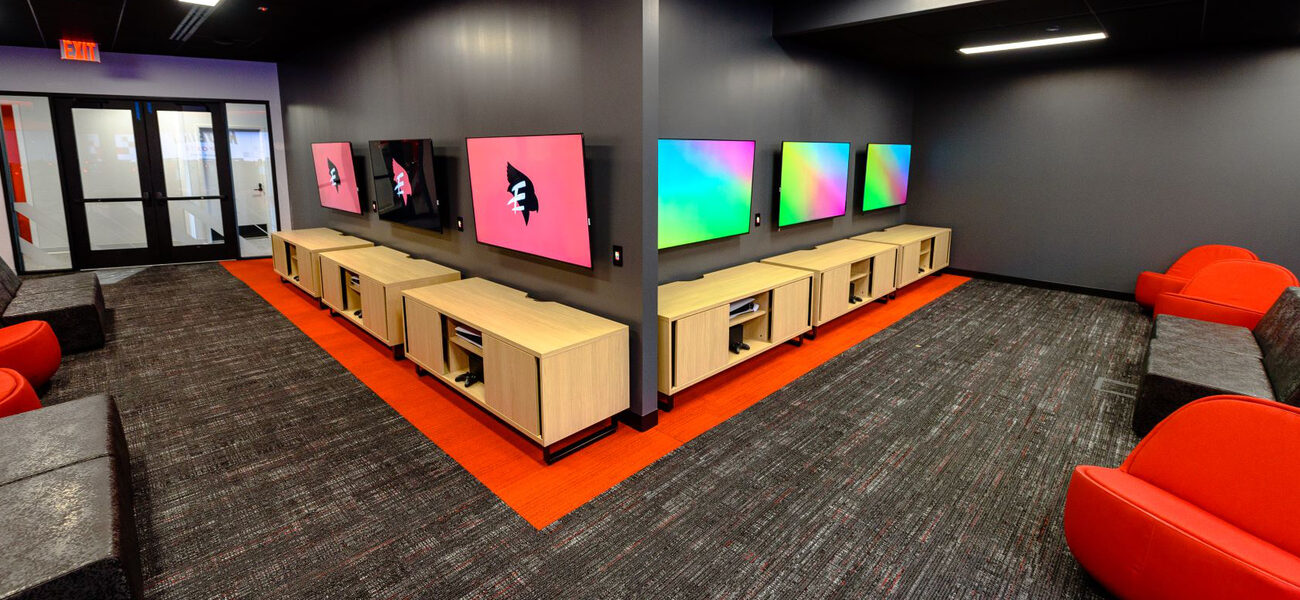With the rise of esports competitions in games like League of Legends, Fortnite, and Overwatch, colleges are under pressure to open campus spaces for both intercollegiate team matches and intramural clubs. Meeting this need requires flexible facility designs, attention to aesthetics, and, importantly, the involvement of related academic and extracurricular programs, says Rob Bailey, executive director of student affairs information technology at Illinois State University.
Esports are multiplayer video games contested by teams with spectators watching the action on streaming services like Twitch. At the professional level, millions of dollars in prize money is on the line. Colleges around the U.S. have been working to provide space for esports teams. In Winter Park, Fla., Full Sail University’s 11,200-sf esports arena opened in 2019 to accommodate up to 100 players and 500 spectators.
Illinois State, with approximately 21,000 students in Normal, Ill., opened its first university-sponsored esports space in 2019, with 12 gaming PCs for student clubs to practice and compete. It was so popular—more than 1,000 students registered as a member in one of the Redbird gaming clubs and in related academic courses and extracurricular activities—that Illinois State established three varsity esports teams and opened a second facility in 2020 in a remodeled racquetball court. Then the administration invested $4.5 million to convert a bowling and billiards center into a new 11,000-sf esports facility, which opened in the fall of 2022. The new center includes 72 gaming PCs, broadcast production space, and six console stations for casual gamers.
“We have two glassed-in competition spaces that have adjacent team rooms,” says Bailey. “Your home team and your visitor team can play and then go into their team room space to converse about what’s next.”
The momentum accumulated organically. “We didn’t have a map and we certainly didn’t know where we were going when we got started,” says Bailey. “We very carefully and iteratively grew esports, both program-wise and facility-wise. We quickly learned that space does not create a successful program, and good program goals are essential to articulating the needs for facility design.”
Decision Factors for Rightsizing a College Esports Facility
Before committing to an esports facility investment, it pays for university administrators to consider the goals driving the decision: “Is this an arena, a gaming center, or is this a learning space? It is all of the above? The goals of these spaces are very different,” says Bailey.
An arena, for example, requires a mature program with competitive teams to justify the dedicated space. Gaming centers serve as multipurpose facilities that support varsity competitions, casual gaming, and spaces to support them. The spaces also serve as experiential learning environments linked to academic programs such as broadcast production and game design. Facilities also can be used to produce revenue from community events, such as summer camps, and through industry partnerships from video game companies that provide income from tournaments and exposure for the school’s esports program.
At Illinois State, administrators decided on a multipurpose facility, building on lessons learned:
- Build a program that represents institutional excellence. In this case, the esports program includes varsity teams for intercollegiate play as well as campus-based clubs and spaces for informal gameplay.
- Support the school’s academic mission. Illinois State students can participate in the esports center as an extension of their coursework in fields such as communications, sports management, fine arts, and video game design; and in extracurricular activities, such as broadcasting for the Redbird Esports Network that streams game coverage.
- Create an inclusive community that fosters student engagement. The esports center at Illinois State is not just for varsity video gamers. It’s a recreational center for clubs and serves as a hub for informal student gatherings.
Elements of a Multipurpose Esports Facility
Multipurpose esports facilities share common elements that serve the goals of hosting competitions, student organization meetings, and more informal gatherings, as well as supporting related academic experiences:
A welcome desk provides an access point for athletes to check in, for groups to schedule meetings and events, to process payments, and to check out gaming equipment. “Don’t leave this out of your design,” cautions Bailey. “The welcome desk provides a crucial customer service experience for your space.”
A competition area represents the focal point of the esports facility, where top players practice and compete in games. It is typically separated from practice spaces and casual gathering spots, but is still visible. This space often contains the best computers, and may include custom desks and cameras positioned to capture video of players in action.
Team rooms are private spaces like locker rooms for players to meet before, during, and after matches. They typically include video displays, so players and coaches can review game action. “Interactive digital touch displays allow for coaches to mark up the gameplay in the same manner that you might have used a whiteboard to draw up a play in a football match,” says Bailey.
PC gaming stations. PC gaming is the core attraction at Illinois State. The number and setup of these stations is determined by the program’s goals, depending on whether it is open to all students, or even the broader community.
The layout of the stations is important: Esports players like to be able to see each other in addition to communicating verbally through their headsets. They prefer to be positioned in a straight line or in a pod. The number of computers needed depends on the competition: Teams of five players face off in League of Legends, three in Rocket League, and six in Overwatch.
“Generally, the best current configuration is a line or pod of six computers,” says Bailey. “But I want to emphasize that titles will continue to change, and you should design space to provide maximum flexibility.”
Spacing between the desks is also important. Gamers don’t like to feel cramped. They also use large mouse pads that take up a lot of desk space. Bailey recommends that PC game console stations be 48 inches wide.
Console gaming, in which players use a system such as an Xbox, PlayStation, or Nintendo Switch, is extremely popular among college students and less expensive than a gaming PC, which can cost $3,000. It’s useful to include spaces in an esports facility for different kinds of video gamers. Consider including ports for console players to connect “retro” game systems from Nintendo and Sega.
A dedicated broadcast production space enables live streaming and recording of competitions and provides students with broadcasting experience. The space can be as simple as a desk with a webcam and a microphone, or as elaborate as a facility with a stage and a control room. “You would be amazed at the quality of production some of these collegiate esports programs are producing. It’s like an ESPN event,” says Bailey. “Wherever you find a successful esports franchise, you’ll find a successful streaming and casting community.”
Casual gathering areas for students – “A great collegiate gaming program goes beyond competition and has a strong emphasis on creating community,” says Bailey.
The Illinois State esports facility gathering area hosts student organizations for the anime club and table games such as Dungeons & Dragons.
Esports arenas, not part of every esports center, are more elaborate theater-like spaces for competitions. They typically include large-format displays to show live gameplay that focuses on the game action, as well as the competitors themselves. “Most institutions will find the greatest value in leveraging existing event space on campus for large esports tournaments,” says Bailey.
Design Recommendations: Flexibility, Attention-Grabbing Aesthetics, Lighting, and Power Loads
It’s challenging to think about “future-proofing” facility designs, because esports are still relatively new and the games themselves continue to evolve. “While we are confident that esports will continue to grow, we don’t know if that is going to be in PC gaming, virtual reality, gaming consoles, or some other completely different format,” says Bailey.
Bailey has found that most campuses locate the esports center in a student activity hub rather than in a residence hall, which risks making the facility feel like it’s exclusive to that hall’s residents.
Bailey shared a few additional recommendations for developing esports facilities.
Flexible floor plans – Adopt the same strategies used in highly flexible classroom spaces to allow for multiple room configurations and multiple furniture configurations in different rooms. A raised floor allows for power and data to be connected to any point in the space.
Bold graphical designs – Esports spaces, often a hotspot on admissions tours, need to capture gamers’ attention.
“These centers are often mirroring the attention-getting graphics from the games that students are playing and incorporate a very tech-heavy design aesthetic,” says Bailey.
Lighting and power controls are also important considerations. Esports gamers prefer dim or dark lighting conditions, which makes dimmable fixtures a good option. Programmable RGB (red, green, and blue) lights in LED fixtures enable managers to set specific colors according to team designs, and to tailor the atmosphere in the room.
Gaming PCs consume a lot of power. While a standard PC station might draw between 100 and 200 watts, the technology vendor Nvidia recently released a new graphics card that pulls 480 watts all by itself, without accounting for other computer components like its central processing unit or random-access memory. Bailey says a facility could expect to support four PC gaming stations on each 20-amp circuit to fulfill power requirements.
In terms of technology infrastructure, Bailey says to think of the esports facility as comparable to a traditional computer lab, except that the gaming PCs will cost two or three times as much as traditional computers. In regards to network infrastructure, “Make sure that the fiber is directly connected to your campus core, so you are getting the lowest ping times for the lowest latency, because every millisecond will make a difference in the success of an esports player in competition,” says Bailey.
Let the Games Begin – A Tour of College Esports Facilities
Bailey says he came across a number of interesting esports facilities in his research for Illinois State’s project:
- University of California at Irvine – Opened in 2016; 3,500 sf; 72 gaming PCs, console stations, meeting rooms, broadcast area. “This is really where college esports got its major start. They started with a single open space that brought together a community of gamers for events and tournaments.”
- Illinois Wesleyan University – Opened in 2020; 5,700 sf; 54 gaming PCs, a glassed-in competition room called the Coliseum, meeting and team rooms, lounge area, broadcast studio. “It is a very impressive looking space. They have really tried to engineer it for flexibility for those changes in the future.”
- Full Sail University – Opened in 2019; 11,200 sf; largest collegiate esports arena in the U.S., 500 seats for spectators, concert lighting and public address system, 10-million-pixel LED wall. “They have really been trying to capture those large-scale collegiate tournaments, and this has opened them up for the possibility of those partnerships with the game publishers to hold big events and tournaments.”
- The Ohio State University – Opened in 2019; 5,000 sf; 80 gaming PCs, five console stations, meeting and team rooms, competition room, open gaming area, broadcast studio. “A tremendous, beautiful facility at their location. They check all the boxes of what you want in a comprehensive facility or program. I liked how they added lockers for students to store their stuff between gaming.”
By Michael S. Goldberg



